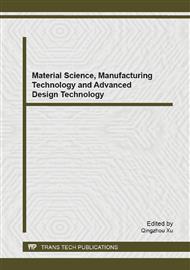[1]
Gao R L, Zhang X Y, Tang Y Y. The discussion about the application of CIP cleaning device for the beer production [J]. LIQUOP MAKING, 2000, 02: 82-83.
Google Scholar
[2]
Zhou C M. The introduction to CIP cleaning system [J]. Beer Science and Technology, 2010, 05: 57-60.
Google Scholar
[3]
Adams, D. and D. Agarwal. Clean-in-place system design [J]. BioPharm, 1988, 2(6): 48–57.
Google Scholar
[4]
Plett, E. A. Rinsing kinetics of fluid food equipment [M]. London: Elsevier Applied Science, 1984, 2: 659–668.
Google Scholar
[5]
Chen A Q. The application of automatic CIP cleaning system in the beverage, beer packaging production line [J]. Beverage Industry, 2010, 11: 38-41.
Google Scholar
[6]
Liu P, Zhao Y, Hu H Z. The applications and precautions of CIP cleaning in modern dairy enterprises [J]. Food global industry, 2001, 06: 57.
Google Scholar
[7]
Hyde, J. M. New developments in CIP practices [J]. Chem. Eng. Prog. 1985, 81(1): 39–41.
Google Scholar
[8]
Wolfgang Maasberg. Commercial-Industrial Cleaning, by Pressure-Washing, Hydro-Blasting and UHP-Jetting [M]. London: Springer, (2012).
DOI: 10.1007/978-0-85729-835-5_4
Google Scholar
[9]
E. Scott Welch. Cleaned-in-place (CIP) systems and controls [J]. Journal of the American Oil Chemists' Society, 1968, 45(7): 368A-370A.
DOI: 10.1007/bf02541315
Google Scholar
[10]
Wan Y Q, He Q, Wang J L. New application of CIP technology in brewery [J]. Liquor-Making Science & Technology, 2001, 01: 70-71.
Google Scholar
[11]
Song X Y. Analysis of cleaning for large beer fermentation tank [J]. Beer Science and Technology, 2003, 06: 41.
Google Scholar
[12]
Cai S B, Zhong J W, Peng W S. The transformation and the role of cleaning process of tank cleaning with pressure [J]. Beer Science and Technology, 2007, 01: 70-71.
Google Scholar
[13]
Yan Q S, Chen G H, Zhang H B, Cheng X M. Preparation of water-based low-foam metal cleaning agent [J]. HEBEI CHEMICAL ENGINEERING AND INDUSTRY, 2001, 04: 38-39.
Google Scholar
[14]
Yan Q S. Formula of warer-based low-foam metal cleaning agent [J], AME Technology, 2002, 07: 18.
Google Scholar
[15]
Zhou Y W, Xu B C, Han F. Application status and development trend of Chinese industrial cleaning technology [J]. China Cleaning Industry, 2010, 01: 33-36.
Google Scholar
[16]
Feng H J, Wu C F, Zhang K L, Chang R H. The test of NF-10 acidic cleaning agent [J]. Beer Science and Technology, 2004, 03: 70.
Google Scholar
[17]
Shen H P. Application of industrial cleaning equipment in the food machinery industry [J]. CHINA FOOD SAFETY, 2012, 03: 70.
Google Scholar
[18]
Fan S Q, Dai Y X. Compatibility characteristics of polyether of low foam cleaning agent [J]. Aviation Precision Manufacturing Technology, 1991, 04: 41-44.
Google Scholar
[19]
Wang R Q, Zhao Q J, Yu W J. The method to improve the utilization of CIP cleaning fluid [J]. Journal of Dairy Science and Technology, 2006, 04: 178-179.
Google Scholar


